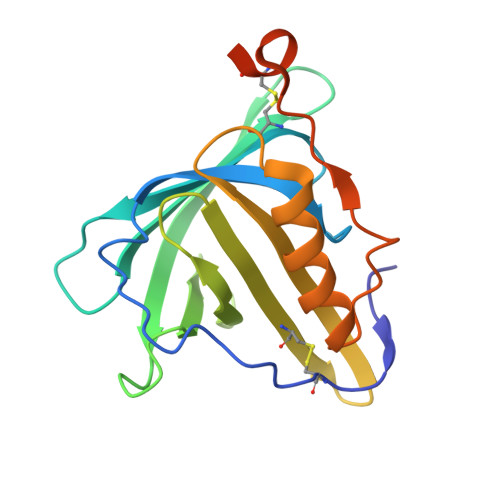Modulation of biliverdin dynamics and spectral properties by Sandercyanin.
Ghosh, S., Mondal, S., Yadav, K., Aggarwal, S., Schaefer, W.F., Narayana, C., Subramanian, R.(2022) RSC Adv 12: 20296-20304
- PubMed: 35919616
- DOI: https://doi.org/10.1039/d2ra02880h
- Primary Citation of Related Structures:
7O2Y, 7O3K, 7YX1 - PubMed Abstract:
Biliverdin IX-alpha (BV), a tetrapyrrole, is found ubiquitously in most living organisms. It functions as a metabolite, pigment, and signaling compound. While BV is known to bind to diverse protein families such as heme-metabolizing enzymes and phytochromes, not many BV-bound lipocalins (ubiquitous, small lipid-binding proteins) have been studied. The molecular basis of binding and conformational selectivity of BV in lipocalins remains unexplained. Sandercyanin (SFP)-BV complex is a blue lipocalin protein present in the mucus of the Canadian walleye ( Stizostedion vitreum ). In this study, we present the structures and binding modes of BV to SFP. Using a combination of designed site-directed mutations, X-ray crystallography, UV/VIS, and resonance Raman spectroscopy, we have identified multiple conformations of BV that are stabilized in the binding pocket of SFP. In complex with the protein, these conformers generate varied spectroscopic signatures both in their absorption and fluorescence spectra. We show that despite no covalent anchor, structural heterogeneity of the chromophore is primarily driven by the D-ring pyrrole of BV. Our work shows how conformational promiscuity of BV is correlated to the rearrangement of amino acids in the protein matrix leading to modulation of spectral properties.
- Institute for Stem Cell Science and Regenerative Medicine Bangalore 560065 India swagatha.ghosh@gu.se subram68@purdue.edu.
Organizational Affiliation:

















